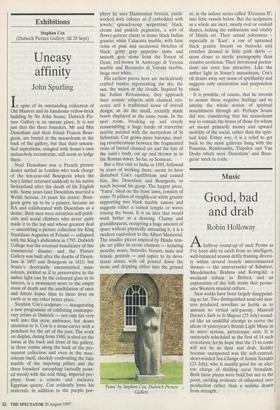Exhibitions
Stephen Cox (Dulwich Picture Gallery, till 28 Sept)
Uneasy affinity
John Spurling
In spite of its outstanding collection of Old Masters and its handsome yellow-brick building by Sir John Soane, Dulwich Pic- ture Gallery is an uneasy place. It is not just that the three founders, Mr and Mrs Desenfans and their friend Francis Bour- geois, are buried in the mausoleum at the back of the gallery, but that their unsatis- fied aspirations, mingled with Soane's own melancholy eccentricity, still seem to lodge there.
Noel Desenfans was a French picture dealer settled in London who took charge of the ten-year-old Bourgeois when the boy's father returned suddenly to his native Switzerland after the death of his English wife. Some years later Desenfans married a Welsh heiress, 14 years his senior. Bour- geois grew up to be a painter, became an RA and collaborated with Desenfans as a dealer. Both men were relentless self-publi- cists and social climbers who never quite made it to the top and whose greatest deal — assembling a picture collection for King Stanislaus Augustus of Poland — collapsed with the King's abdication in 1795. Dulwich College was the eventual beneficiary of this commercial disaster and the Picture Gallery was built after the deaths of Desen- fans in 1807 and Bourgeois in 1811; but Soane's doctrinally uncommitted mau- soleum, pickled as if in preservative in the amber light cast by the coloured glass in its lantern, is a monument more to the empty stasis of death and the annihilation of once and future hopes than to three lives on earth or in any other better place.
Stephen Cox's sculpture — inaugurating a new programme of exhibiting contempo- rary artists at Dulwich — not only fits very well into this eerie ambience, but draws attention to it. Cox is a stone-carver with a penchant for the art of the past. The work on display, dating from 1980, is sited on the lawns at the back and front of the gallery, in three rooms along the back of the per- manent collection and even in the mau- soleum itself, cheekily confronting the fake marble of the imposing pillars and the three founders' sarcophagi (actually paint- ed wood) with the real thing, imperial por- phyry from a remote and exclusive Egyptian quarry. Cox evidently loves his materials: in addition to the purple por- phyry he uses Hammamat breccia, patch- worked with colours as if embedded with jewels; spinach-soup serpentine; black, cream and pinkish pegmatite, a sort of flower-pattern chintz in stone; black Indian granite; white Calacatta marble, with faint veins of pink and occasional blotches of black; gritty grey peperino stone and smooth grey stone from the Forest of Dean; red-brown St Ambrogio di Verona marble and Bronzetto di Verona marble, beige over white.
His earliest pieces here are meticulously crafted tondos representing the sky, the sun, the moon or the clouds. Inspired by the Italian Renaissance, they approach their cosmic subjects with classical reti- cence and a traditional sense of overall design; as do the small, recently made bowls displayed in the same room. In the next room, breaking up and crazily reassembling a huge tondo of travertine marble painted with the martyrdom of St Sebastian, Cox grows more baroque, start- ing reverberations between the fragmented ruins of buried classical art and the fate of the saint's body, cut up and thrown in to the Roman sewer. So far, so Soanean.
But a first visit to India in 1985, followed by years of working there, seems to have disturbed Cox's equilibrium and caused him, like Desenfans and Bourgeois, to reach beyond his grasp. The largest piece, `Yatra', sited on the front lawn, consists of some 70 pillars of roughly-cut white granite supporting two black marble canoes and suggests either a ruined temple or waves tossing the boats. It is an idea that would work better as a drawing. Clumsy and grandiloquent, occupying a huge amount of space without physically animating it, it is a modern equivalent to the Albert Memorial. The smaller pieces inspired by Hindu tem- ple art pilfer its erotic element — isolating mouths, noses, buttocks, breasts, male and female genitals — and aspire to its devo- tional status, with oil poured down the stone and dripping either into the ground
'Mara' by Stephen Cox. Dulwich Picture ,
Gallen or, in the indoor series called 'Etruscan II', into little vessels below. But the sculptures as a whole are inert, mostly oval or ovaloid shapes, lacking the enthusiasm and vitality of Hindu art. Their sexual references especially in `Kani', a row of upturned black granite breasts on buttocks and crotches dressed in little pink skirts seem closer to sterile pornography than creative eroticism. Their devotional preten- sions are even less attractive. Like the amber light in Soane's mausoleum, Cox's oil drains away any sense of spirituality and suggests only ostentation and purposeless ritual.
It is possible, of course, that he intends to arouse those negative feelings and to satirise the whole notion of spiritual nourishment through art. Perhaps Soane did too, considering that his mausoleum was to contain the bones of those for whom art meant primarily money and upward mobility of the social, rather than the spiri- tual kind. Either way, it is a relief to get back to the main galleries hung with the Poussins, Rembrandts, Tiepolos and Van Dycks which were Desenfans' and Bour- geois' stock in trade.


















































 Previous page
Previous page